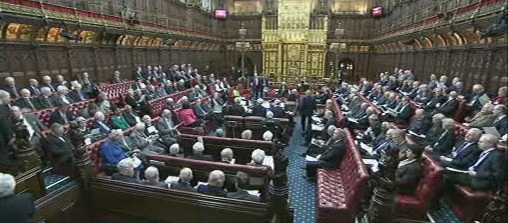David Herdson asks: Where are UKIP’s 34 peers?

An unreformed Lords shouldn’t be a closed shop for the old parties
Sex, money and people in high places all make for a good scandal, as Lord Sewel found out to his cost this last week. And as usually happens when a member of the Lords gets into trouble, the opponents of the institution cite it as an example of the need for reform of it, or even its outright abolition.
Not that there’s a chance of serious reform any time soon. It suits both Conservative and Labour governments to keep a second chamber that doesn’t pose too much of a threat to the first and into which they can parachute placemen and -women. It suits the Lib Dems too to keep their hundred peers in place while their representation in the Commons lies in single figures; a point which may have to the forefront of their thinking when they folded so easily on the subject in the last parliament.
Because the fact is that even more than the Commons, the Lords is a club for the established parties: the Tories, Labour and Lib Dems have 539 peers between them; all other parties, just twelve. There are of course more than two hundred non-party peers – crossbenchers, unaligned and bishops – but while that provides diversity in one sense, it does little to reflect changing voting patterns.
The last government in its coalition agreement pledged itself to appoint new peers with the intention of reflecting the previous election. It never quite got there and it was always a bit of a silly objective: were it to be followed rigorously, the see-saw effect of electoral swing combined with the length of peers’ service would see numbers in the Lords expand out of all control. To have been pushing Lib Dem membership up to 23% when their opinion poll rating was marooned in single figures would have looked unjustifiable.
However, that objection can be navigated if we take not the last election as the baseline but an average of the last three, both to mitigate the see-saw effect and on the basis that 15 years is closer (though probably still short) of the average length of a peer’s service. If, to avoid the introduction of flash-in-the-pan parties, we also introduce a 3% UK-wide threshold, or a 10% threshold for the regional parties in Scotland, Wales and Northern Ireland, then on the basis of 550 party peers there’d be the following numbers:
Con 202 (actual 226)
Lab 181 (actual 212)
LD 101 (actual 101)
UKIP 34 (actual 3)
SNP 15 (actual 0 on principle)
DUP 4 (actual 4)
Plaid 3 (actual 2)
Sinn Fein 3 (actual 0 on principle)
SDLP 2 (actual 0)
UUP 2 (actual 2)
The Greens fall below the threshold (the three Green parties within the UK averaged just 1.9% between them over the 2005-15 period) but do have one member of the Lords at present.
Various things stand out on that list: the existing bias to the Tories and Labour (soon to be increased, apparently), the Lib Dems being spot on their ‘quota’, and the near-fair representation of those regional parties which allow their members to participate in the Lords. But by far the most striking is the scale of UKIP’s under-representation.
There may be some justification for this. On the criteria above, UKIP wouldn’t have crossed the qualifying threshold until this last election (their average from 2001-10 was only 2.3%) but even if they were expected to work up to their full allocation over three parliaments, they’d still be entitled to eleven or twelve in this one: four times what they actually have.
The House of Lords has never justified itself on democratic legitimacy but on grounds of effectiveness. Which is all very well but the fact is that democratic arguments are put forward when it suits one politician or another to do so. So would it really hurt to give a voice to the one in eight at the last election who voted for Farage’s party? Who knows – they might even brighten the place up.
